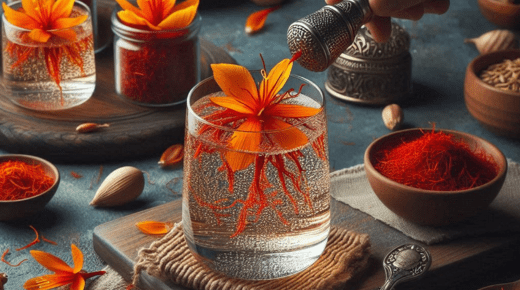Saffron, one of the priciest spices, can do more than just make risottos and biryanis special. For thousands of years, it has been a key ingredient in many dishes, from ancient Persian and Greek to today’s Michelin-starred meals. Saffron’s soft, honey-like scent and its sweet, slightly bitter taste go well with many foods.
This spice is great for both sweet and savory dishes, making it a favorite among chefs and home cooks. But how do you use saffron to get the best flavor? Let’s dive into the world of saffron pairings and find out what foods go well with it.
Key Takeaways
- Saffron is a versatile spice that can elevate both sweet and savory dishes.
- Saffron is commonly paired with herbs, spices, fruits, vegetables, and seafood in a variety of global cuisines.
- Saffron’s sweet, floral notes pair well with ingredients like honey, citrus, and dairy, while its subtle bitterness complements earthy flavors.
- Saffron is a labor-intensive spice to harvest, contributing to its high cost and making it a prized ingredient in culinary creations.
- Saffron’s unique flavor profile allows it to be used in a wide range of dishes, from appetizers to desserts.
What is Saffron and Why is it So Expensive?
Saffron is the dried stigma of the crocus flower, known as Crocus sativus. It is believed to have started in Greece. Now, it’s mainly grown in the Mediterranean and Middle East, where it thrives best. The high price of saffron comes from how hard it is to harvest and the small amount each plant produces.
Origins and Cultivation of Saffron
The true origins of saffron are a mystery, but it’s thought to be cultivated now rather than found in the wild. Today, the top saffron producers are in the Mediterranean and Middle East. These places have the best conditions for growing saffron.
The Labor-Intensive Harvesting Process
Each crocus plant gives only three stigmas, which must be picked by hand during a short autumn season. It takes about 75,000 flowers to make just one pound of saffron. This hard work makes saffron very expensive, costing from $10 to $20 per gram for top-quality saffron.
Flavors That Go with Saffron
Saffron is a spice that brings a unique and captivating flavor to many dishes. It’s known for its bright golden-yellow color and delicate, floral smell. This spice pairs well with many herbs, spices, fruits, vegetables, and proteins. It can make both savory and sweet dishes better by adding its special touch.
Herbs and Spices to Pair with Saffron
There are many herbs and spices that go well with saffron. Some top choices include basil, fennel seed, coriander, cinnamon, and cloves. Other great options are nutmeg, mace, cumin, curry powder, vanilla, and cardamom. These spices and herbs work together to make saffron’s flavor even better.
Fruits, Vegetables, and Other Foods That Complement Saffron
- Vegetables: Carrots, fennel bulbs, onions, garlic, shallots, leeks, ginger, turmeric, potatoes, parsnips, asparagus, artichokes, eggplant
- Fruits: Oranges, lemons
- Proteins: Chicken, fish, shellfish
- Grains and Starches: Rice, pasta
- Dairy: Cream, butter, cheeses
- Nuts: Nuts
- Legumes: Beans
When you mix these ingredients with saffron, you get a mix of flavors that delight your taste buds. Saffron can be used in soups, stews, rice dishes, or even desserts. It makes the dish special, adding a unique taste that people love all over the world.
Saffron Pairings
Cuisine
Dish Examples
Carrots, fennel, onions, garlic, ginger, turmeric
Mediterranean, Indian
Chicken biryani, saffron risotto, saffron-infused tagine
Oranges, lemons, butter, cream, cheeses
Italian, French
Saffron crepes, saffron-infused pasta, saffron béchamel sauce
Shrimp, mussels, clams, fish
Spanish, Moroccan
Saffron-infused seafood stew, saffron-tinged paella, saffron-scented bouillabaisse
Knowing which flavors go well with saffron opens up new possibilities for chefs and home cooks. It helps them create dishes that are exciting and memorable.
Conclusion
Saffron is a spice that can make many dishes better, both savory and sweet. By learning about where it comes from and how it’s made, cooks can use it to its fullest. It adds a special touch to Mediterranean and Indian dishes, and even to new recipes.
This spice is known for its bright red color and a smell like turmeric. Chefs and food lovers all over the world love it. It’s grown mainly in Iran and Spain, and making it is hard work. Thousands of delicate parts must be picked by hand, making saffron very expensive.
But saffron is more than just rare and costly. It can mix well with many foods, like herbs, fruits, vegetables, and dairy. You can use it in many ways, from Middle Eastern dishes with cardamom to desserts with cinnamon. Its unique taste and color make it a key ingredient for many recipes.
FAQ
What is saffron and why is it so expensive?
Saffron comes from the dried pistil of the crocus flower, known as Crocus sativus. It’s thought to have originated in Greece. The cost is high because each plant yields only three stigmas. Harvesting them by hand is necessary.
It takes about 75,000 flowers to get a pound of saffron. These flowers bloom for just two weeks in autumn. Farmers must work fast to gather them before they disappear.
What does saffron taste and smell like?
Saffron has a soft flavor that’s very concentrated. It smells like honey, hay, and pollen.
What foods pair well with saffron?
Saffron is great in soups, stews, and rice dishes. It also shines in sweet recipes. It matches well with carrots, fennel bulbs, onions, and more.
Other good pairings include garlic, shallots, leeks, ginger, turmeric, potatoes, parsnips, asparagus, artichokes, oranges, lemons, beans, eggplant, nuts, chicken, fish, shellfish, rice, pasta, cream, butter, and cheeses.
What herbs and spices complement saffron?
Basil, fennel seed, coriander, cinnamon, and cloves are great with saffron. So are nutmeg, mace, cumin, curry powder, vanilla, amchoor powder, cardamom, tarragon, chai spices, and chervil.



